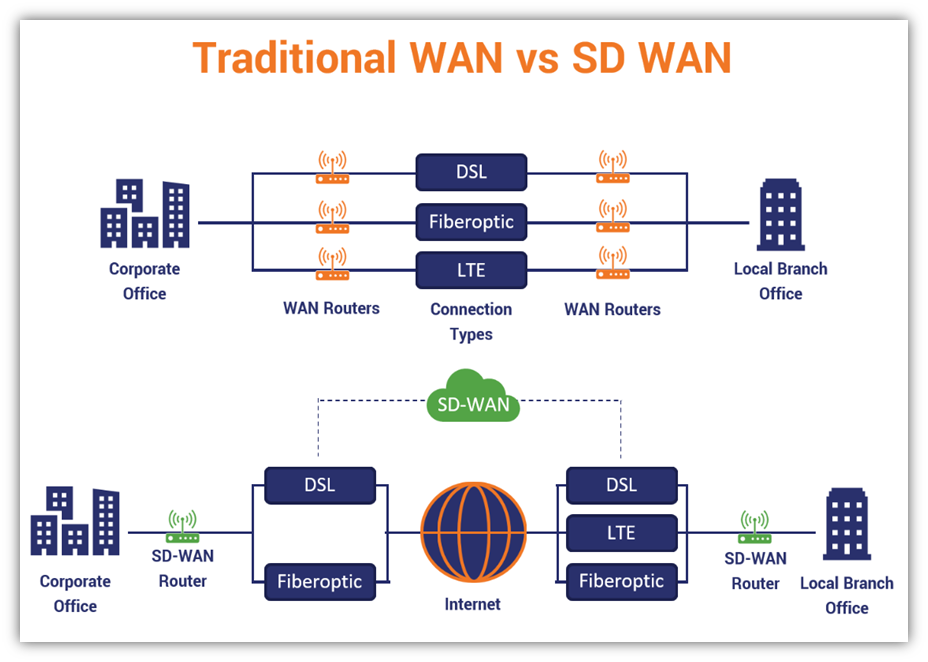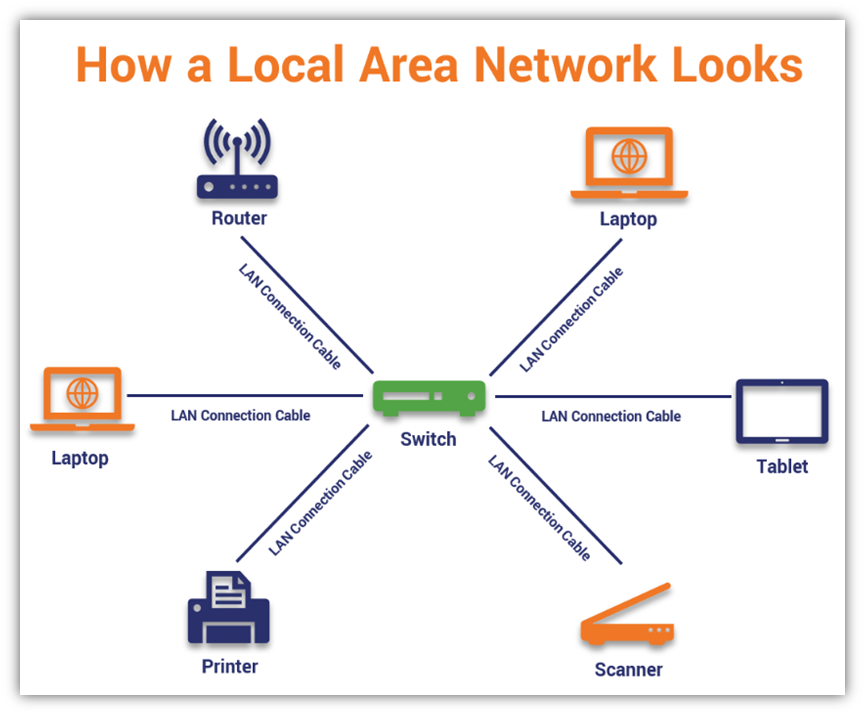SD-WAN: How to Use It to Transform Your Digital Networks
Why are organizations turning to software-defined wide area networks? Explore why organizations should consider adopting an SD-WAN approach to revamp their digital networks
Editor’s Note: This is a guest blog contribution from Nahla Davies, a software developer and IT/tech writer. Davies explores what a software defined wide area network is, how it’s commonly used, and how you can transition your business to using this connectivity approach.
Increasing your organization’s networking capabilities, security, and bandwidth is necessary to enable corporate growth. This is particularly true for multi-site organizations that increasingly rely on cloud apps, teleconferencing, and video streaming tools. The COVID-19 pandemic has exacerbated these bandwidth concerns; outdated wide area networks (WANs) are incapable of scaling adequately to meet increasing demand, forcing organizations to look for a better solution to support their digital strategies.
It has been possible for individuals and businesses of all sizes to access high-speed Internet connections and critical data thanks to software-defined wide area networks, or SD-WANs. The SD-WAN market, worth $1.4 billion in 2019, is predicted to be worth $43 billion by 2030, according to Prescient & Strategic (P&S) Intelligence research. This means a compound annual growth rate (CAGR) of more than 38% over the forecast period (2020-2030).
But what is an SD-WAN and how could using one benefit your organization?
Let’s hash it out.
What Is a Software-Defined Wide Area Network? SD-WAN Explained
SD-WAN is the abbreviation for “software-defined wide area network.” It’s a way for you to connect your devices, systems and offices globally using multiple network connection methods, alternating between connections based on whatever provides the greatest connectivity in any given moment. The idea behind this flexible approach of distributing (routing) traffic across your network is to help you save money and increase network performance.
SD-WAN is a term that refers to a programmatic and automated way to manage your global enterprise’s network connectivity and circuit expenses through the use of virtual services. This software-based virtual network technology is more relevant than ever before for an increasingly remote workforce. It can assist you in providing your company’s network with reliable connectivity and significantly help tackle internet of things (IoT) security risks to ensure data privacy.
Other features of the SD-WAN include connecting your onsite and offsite resources instantly. SD-WANs use software to manage the connection between remote branches, data centers, and cloud instances.
Need a visual aid to understand these concepts? Check out this video:
SD-WAN Versus a Traditional WAN or LAN
A local area network, or LAN, is the traditional network that works within your on-premises office to allow devices locally to connect and communicate with one another in a single, limited area. This differs from a vast wide area network (WAN), which connects devices located in remote offices or branches with applications and other network resources. WANs require a multitude of routers to operate at the locations to enable the branches to communicate — each of which must be managed and have rules created for it by your IT admin.
In general terms, LAN refers to the interconnected devices from within a building, while WAN refers to the interconnected devices from outside of the building. Both of these differ from an SD-WAN, which refers to routing traffic to different remote locations. SD-WAN also improves the hybrid WAN through packet management, bandwidth efficiency, dynamic path optimizations, applications monitoring and improved performance.
SD also makes it a lot easier to separate networks (such as public, private, and IoT networks). Historically, this would be a challenging task because it would require different switches or subnets. But some SD-capable routers can handle this separation fairly easily and quickly.


Popular Use Cases for SD-WAN
Before implementing an SD-WAN, it is vital to identify and organize your organization’s needs and its role in developing your business strategy. The following use cases represent a set of possible uses of SD-WANs (depending on the particular environment and your specific business goals). Always make sure to ask how SD-WANs can benefit your business and customers.
1. Direct Internet Access (DIA)
Integrated and cloud-based security offers better protection against Internet assaults. Dedicated internet access frees up bandwidth on the WAN while enhancing security and speeding up internet usage for branch employees and visitors. Branch employees and guests can connect locally via DIA, which reduces traffic on your WAN and improves internet speed. As a result, the branch now has a direct connection to the Internet, saving time and money.
Despite being predominantly software-centric, SD-WAN still requires some sort of hardware devices to operate (i.e., SD-WAN routers). However, while traditional WAN requires quite a lot of work and time to handle network operations, SD-WAN can reduce those efforts to a minimum. In fact, several SD-WAN devices offered today on the market such as devices offered by Cisco are plug-and-play (zero-touch provisioning) and brought online without administrative intervention at the branch/remote office.
2. Branch-to-Branch Connectivity
Organizations that need high-throughput, continuous connections from multiple offices have traditionally relied on multiprotocol label switching (MPLS) circuits or virtual private network (VPN) tunnels. MPLS circuits are a telecommunication routing method that transfers data from one node to another by identifying existing pathways between endpoints, while VPNs are designed to encrypt data shared over public networks.
SD-WAN has emerged as a new solution for branch-to-branch connections. It can minimize the burden and cost of managing the connectivity of branch offices with MPLS. SD-WAN simplifies and accelerates the procedure, so no excess time is wasted in standard ways to set up internet breakouts from branch/remote offices is time-consuming and mistake-prone. In contrast to typical networks, SD-WAN solutions do not depend on the traditional hub-and-spoke model, which might cause performance issues.
Existing ways to safeguard all user sites can be slow and error prone. Consider a scenario where dozens of users use a cloud-based service from different locations. SD-WAN can conveniently connect those users into one virtual location using SD-centralized WAN control and automation.
When branches link directly to the data center or cloud, transit time and overhead are reduced, bottlenecks are eliminated, and application performance is improved.
3. Application Performance Optimization
SD-WANs help network administrators define service-level agreements (SLAs) for specific applications by using SD-WAN to craft and enforce their own internal SLAs that match the requirements of the business. Specifically, teams can set parameters for uptime, fix times, and latency. This ensures that traffic is routed efficiently to meet those SLAs while also alleviating congestion, improves application performance, and possibly lowers networking costs. It allows the use of centralized application controls, which automatically direct critical programs around network difficulties
When an SD-WAN is in place, applications no longer need to be re-routed through the central site. SD-WAN enables managers to prioritize mission-critical apps and route traffic via the best transport available. For example, if you need to prioritize voice traffic over email, you can configure SD-WAN devices to prioritize voice packets (think VoIP) over other data. This will contribute to ensuring a smooth call experience.
Moreover, SD-WAN managers can prioritize key applications while deprioritizing less important ones using application-aware quality of service (QoS) capabilities. This can be used to offer precedence to the most critical applications, resulting in faster response times when the apps are managed directly. They can also monitor the SD-WAN environment at a high level to detect faults in real time.
4. Cloud Migration
The superior branch and cloud connectivity, application prioritization, and better visibility into network traffic are all good reasons why it’s worth considering SD-WAN for your cloud-first strategies.
Traditional WANs can only support applications from a central data center. But SD-WANs have been designed to fulfill the most stringent demands of cloud computing. They:
- Enable direct cloud access to all applications regardless of where the employee is located physically.
- Support application-based routing, allowing every app to use the most appropriate wide-area service per its needs.
- Enable all organization’s branches to get direct access to the internet.
On top of this, multi-cloud apps offer visibility and help simplify management.
6 Benefits of Transitioning to SD-WAN
Now that we’ve covered the basics of SD-WAN, let’s look at some of how SD-WAN can help enable digital transformation within your organization.
1. Secure Networks With Comprehensive Data Encryption
Experts aren’t in agreement about the security of SD-WANs. Some say they offer better security; others say they provide weaker security. Security teams would be wise to keep in mind that just because SD-WAN offers encrypted traffic as an initial level of defense, further defenses will be a must. But encryption isn’t everything; because you’re talking about a distributed system, encryption alone won’t cover all security aspects. You need other protections in place as well.
However, there is no industry standard for implementing security into SD-WAN. Several approaches include:
- Ensuring PCI DSS Compliance — Always ensure PCI-DSS compliance when transmitting sensitive customer or business financial data. SD-WAN allows you to segregate POS systems and other critical networks so you can isolate the POS system and its transmitted financial information from the rest of the network (better for data security). This is possible thanks to the flexible segmentation and provisioning capabilities that SD-WAN offers.
- Enabling encryption — Many SD-WAN tools enable you to use AES-256 encryption to secure traffic by application, so you can protect site-to-site traffic at any of your branch locations.
- Using next-generation firewalls — Even though most SD-WAN solutions come equipped with built-in firewalls, they often only include basic security filters such as packet filtering to reduce unauthorized access. However, they lack end-to-end coverage that remote enterprises require. Next-generation firewalls offer more advanced security methods, including deep packet inspection (DPI) and intrusion detection and prevention capabilities.
On that last note, firewalls included in low-cost SD-WAN appliances especially are often no different from those found in routers sold by big-box electronics stores. SD-WAN may have some capabilities that appear to improve cybersecurity, but these technologies aren’t always as robust as they would appear to be. Some SD-WAN suppliers advise you to replace them with a separate cloud-based firewall solution. This will also enable you to implement a centralized policy control for all locations and, when needed, push policy changes to multiple branches in a matter of seconds.
A new trend that complements SD-WAN and security technologies, known as SASE (an acronym for Secure Access Service Edge that was created by Gartner), can help your network be secure. In a nutshell, SASE is a kind of SD-WAN on steroids. It can do everything SD-WAN can do and more. It provides advanced, integrated security features, and it’s deployed in the cloud. Thanks to SASE, organizations can easily implement zero trust security (i.e., no device, user, or system should be trusted by default).
2. Fast and Dependable Connectivity
Enterprise networks usually fail to keep pace with the digital transformation of their consumers. SD-WAN can offer the necessary adjustments. It can help businesses support digital technologies such as voice over IP (VoIP), IoT, and corporate productivity apps.
Companies can use SD-WAN to establish fast and dependable connectivity for next-generation services and bring all their branches, sites, or locations on-net for business applications. They can do all this while also improving their capacity to track and regulate end-user experience at each location.
3. Better Network/Service Availability and Uptime
To succeed in the digital age, your company must first decide whether to implement a digital transformation strategy. However, a seamless failover is just as important if a critical process is dependent on uptime and availability. You might also want to look into application recognition with deep SSL inspection and traffic steering. The advantage of SD-WAN is its capacity to fine-tune and alter connections to assure peak performance.
4. Increased Data Transportation Flexibility
SD-WAN provides flexibility and agility through dynamic resource allocation, application-aware traffic routing, and short lead times for adding capacity and connectivity. Zero-touch provisioning and automatic network administration also simplify and minimize operation and management.
Creating an underlay network using SD-WAN is a lot more flexible than a traditional WAN. Paired with other integrations (such as ADSL, VDSL, and even 4G LTE), there’s virtually no limit to what you can do. This flexibility in transportation will enable branches to be connected more efficiently, regardless of their geographical location or any carrier limitations.
Utilizing the most cost-effective or acceptable bandwidth is possible depending on where a business or site is located.
Thanks to a centralized control base, it intelligently and securely routes traffic across several locations while concurrently adjusting bandwidth where it is most needed. Enterprises can benefit from broadband hauls without having to dismantle everything.
5. Instant Return on Investment
Organizations may expect a big return on their investment with a wholly integrated SD-WAN solution. Most IT executives predict at least 25% to 50% ROI from SD-WAN.
How? You may see an immediate return on investment due to:
- Reduced infrastructure costs
- Greater efficiency and reliability of cloud-enabled network services
- Consolidation with intelligent, flexible, and secure routing
- Greater flexibility due to on-premises or cloud-based controllers
- Integrated LTE connectivity
In some cases, enterprises may expect a 100% ROI from a fully integrated SD-WAN solution within three years. Some clients can accomplish this in just one year of implementation.
Hence, there’s less need to spend money on more expensive multi-protocol label switching (MPLS) links because direct internet links can handle the need for more bandwidth.
6. Preparation for Future Digital Innovations
SD-WAN becomes one component of the giant digital transformation puzzle in a business setting. Shifting to a software-driven virtual network could pave the way for future digital innovations because digital transformation requires the right mindset and a plan.
Remember P&S’s SD-WAN market size increase to $43 billion (by 2030) mentioned at the beginning of this article? This may be true for a variety of reasons. For starters, modern workplaces increasingly need to simplify their networks and more flexibility and efficiency when it comes to deploying cloud-based solutions.
If your company relies on a traditional WAN, you’ll want to consider turning to infrastructure-as-a-service (IaaS) and SaaS. Once done, you can add SD-WAN and replace your router-centric WAN with it. It’ll help you ensure reliable connections, faster access to applications, and integrated security. It may also help you cut costs by streamlining and automating your remote app distribution to offices globally.
How to Transition Your Existing Digital Network to SD-WAN

Right from the outset, security and networking specialists need to work together to develop comprehensive security policies with scalability in mind.
While you’re at it, don’t forget to define your transformation goals and SD-WAN solution scope and then move on to the following steps:
1. Assess Your SD-WAN Management Portal
Your SD-WAN management portal needs to be robust. So, you must identify if there are any issues with the SaaS application, data center, device stack performance, and network. Ensure that the application and connectivity health can be viewed in a single dashboard. It makes it easier to identify and report problems, ensuring that end-user performance is visible. If you want to make network modifications and configurations at any branch office in any part of the world, you should be able to use a portal.
2. Adapt to Real-Time Changes
Security solutions, such as segmenting and encrypting network traffic, must be able to respond to changes in the network that occur in real-time. The reality is that keeping up with the dynamic connections is essential to SD-WAN operations. This method can help the security function track and analyze data while also encrypting and decrypting with SSL/TLS so security teams can stay on top of potential security concerns.
3. Automate Your Security Mechanisms
SD-WANs are designed with integrated, automated security mechanisms built into the network as a best practice. As noted previously, just be aware that certain SD-WANs come equipped with only basic security features (such as basic firewalls); as such, you may want to consider updating to stronger versions.
4. Mitigate Software Vulnerabilities
Modern tech may introduce new gaps into your network architecture, compromising its security. Ensure that your SD-WAN provider has a rigorous vulnerability scanning mechanism and quality assurance (QA) process before releasing their code to the production environment. You should also inquire about their approach to security regarding industry and regional compliance considerations or whether they have conducted any vulnerability scanning and obtained the results.
Lastly, ensure that your SD-WAN provides regular updates to fill security patches.
Top Criteria for Selecting an SD-WAN Vendor
Corporate decision-makers and network planners intending to install an SD-WAN should consider a set of criteria that helps identify a solution’s capabilities and whether they align with the company’s goals. Here are some factors you should look for while picking an SD-WAN vendor.
1. Strong Network Security
When selecting an SD-WAN vendor, it’s good to consider security concerns. Businesses should partner with an SD-WAN provider that places a high priority on security when offering the service. Secure tunnels and encrypted traffic are standard features in SD-WAN, which provides a significant layer of security.
An IT provider, on the other hand, should provide additional layers of security such as:
- Round-the-clock monitoring. This should be managed and provided by a managed service provider (MSP) that can monitor and report on its ongoing security status.
- Automated threat detection. This can be managed via real-time threat detection software.
- Managed firewalls. Make sure the service covers the administration, maintenance, and monitoring of your firewalls
- Alerts and notifications. You should be notified instantly regarding potential security breaches
- Security incident remediation. What steps are in place to ensure that the breach will be addressed if/when it occurs? Plan ahead of time.
This is all part of laying the groundwork for the overall design you’ve chosen.
2. Control and Visibility
To effectively manage a network, optimize application performance, and keep the entire environment safe, it’s essential to have comprehensive visibility in every aspect of it. As SD-WAN evolves, it can resolve issues more quickly and gain more insight into future expansion.
3. Features and Customization Capabilities
The extensibility of SD-WAN providers should be considered when evaluating the qualities of their products and services. Also, make it a priority to simplify the process of adding further capabilities that promote scalability when needed, such as:
- Cloud connectivity
- Encryption key rotation
- Data Analytics
- Programmable APIs (so you can customize and scale SD-WAN gear’s configurations)
4. WAN Bandwidth Requirements
Think about what your WAN bandwidth needs are now and how they might grow in the future (three-five years). Ensure you’re getting the bandwidth you need to get the most out of your system.
As a general rule, the average small business with 10 or fewer employees shouldn’t need more than 10-15 Mbps. But a business that involves downloading large files of content on a regular basis, backup services, and cloud-based file-sharing services will likely need at least 50 Mbps.
5. Costs
Due to the SD WAN’s lack of hardware controls, it’s often regarded as being less expensive than traditional hardware-based networks. But there’s no doubt that the cost of an SD-WAN solution differs from one provider to another. Monitor your consumption expenditures to ensure they’re decreasing as anticipated.
If you’re content with the performance, make sure you only pay for what you’re getting. Don’t settle for shoddy work at a premium price.
6. Deployment Capabilities
It is now possible for your company to centrally manage the deployment of services across a distributed network using SD-WAN and network function virtualization (NFV), or utilizing virtual machines in place of physical appliance hardware.
Final Thoughts on Transforming Your Digital Networks With SD-WAN
SD-WAN provides an effective way for businesses to manage their remote network connectivity means via virtual services. Businesses globally are already benefiting from SD-WAN, and further technological advancements can inevitably increase the amount of business support they provide.
Cloud and SaaS services like Workday, Salesforce, Microsoft 365, and Dropbox can benefit from SD-WAN technology optimized for excellent application performance in on-premises data centers and public or private clouds. This way, cloud-first companies can deliver higher application quality of experience (QoEx) to their customers.






































![A Look at 30 Key Cyber Crime Statistics [2023 Data Update]](https://www.thesslstore.com/blog/wp-content/uploads/2022/02/cyber-crime-statistics-feature2-75x94.jpg)












5 Ways to Determine if a Website is Fake, Fraudulent, or a Scam – 2018
in Hashing Out Cyber SecurityHow to Fix ‘ERR_SSL_PROTOCOL_ERROR’ on Google Chrome
in Everything EncryptionRe-Hashed: How to Fix SSL Connection Errors on Android Phones
in Everything EncryptionCloud Security: 5 Serious Emerging Cloud Computing Threats to Avoid
in ssl certificatesThis is what happens when your SSL certificate expires
in Everything EncryptionRe-Hashed: Troubleshoot Firefox’s “Performing TLS Handshake” Message
in Hashing Out Cyber SecurityReport it Right: AMCA got hacked – Not Quest and LabCorp
in Hashing Out Cyber SecurityRe-Hashed: How to clear HSTS settings in Chrome and Firefox
in Everything EncryptionRe-Hashed: The Difference Between SHA-1, SHA-2 and SHA-256 Hash Algorithms
in Everything EncryptionThe Difference Between Root Certificates and Intermediate Certificates
in Everything EncryptionThe difference between Encryption, Hashing and Salting
in Everything EncryptionRe-Hashed: How To Disable Firefox Insecure Password Warnings
in Hashing Out Cyber SecurityCipher Suites: Ciphers, Algorithms and Negotiating Security Settings
in Everything EncryptionThe Ultimate Hacker Movies List for December 2020
in Hashing Out Cyber Security Monthly DigestAnatomy of a Scam: Work from home for Amazon
in Hashing Out Cyber SecurityThe Top 9 Cyber Security Threats That Will Ruin Your Day
in Hashing Out Cyber SecurityHow strong is 256-bit Encryption?
in Everything EncryptionRe-Hashed: How to Trust Manually Installed Root Certificates in iOS 10.3
in Everything EncryptionHow to View SSL Certificate Details in Chrome 56
in Industry LowdownPayPal Phishing Certificates Far More Prevalent Than Previously Thought
in Industry Lowdown